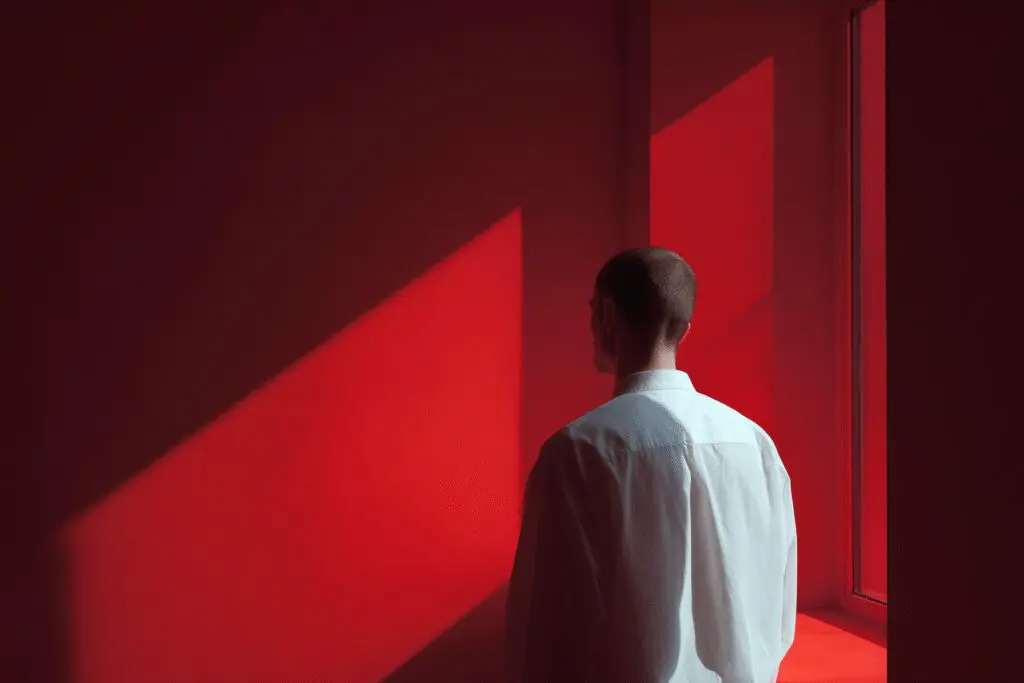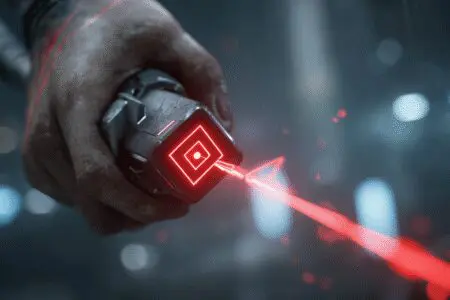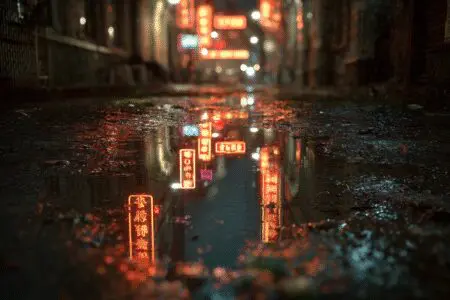Have you ever stopped mid-game, not to fight a boss or solve a puzzle, but just to stare at a sunbeam slicing through a dusty room? Or maybe you’ve noticed how a neon sign in a futuristic city casts a vibrant, colorful glow on the wet pavement below. That incredible sense of realism, the feeling that a digital world is truly alive, isn’t an accident. More often than not, it’s the magic of advanced lighting. So, what is global illumination in games?
Simply put, it’s a sophisticated system for simulating how light behaves in the real world—not just traveling in a straight line, but bouncing, reflecting, and bleeding color onto every surface it touches.
This technology is the single biggest leap towards photorealism in modern gaming. It’s the crucial difference between a world that looks flat and artificial and one that feels tangible and immersive. For years, developers have been chasing this graphical holy grail, and now, it’s finally becoming a reality in the games we play every day. This article will break down exactly what global illumination is, how it works its magic, and why it’s fundamentally changing the way our virtual worlds look and feel.
More in Graphics Optimization Category
Why Is Direct Lighting Not Enough for Realism?
To understand why global illumination is such a game-changer, we first need to look at how lighting used to be handled. For decades, games relied almost exclusively on a technique called direct lighting.
The concept is straightforward. Imagine a single lightbulb in a completely dark room. With direct lighting, the game’s engine calculates a straight line from the lightbulb to any object it hits. The spot where the light hits is illuminated, and a harsh, dark shadow is cast behind it. And that’s it. The process stops there.
Consequently, any part of the room not in the direct path of that light ray remains pitch black. The light doesn’t bounce off the floor to softly light the ceiling. It doesn’t hit a red chair and cast a faint red glow on the white wall next to it. Direct lighting only cares about the first thing a ray of light touches. This is computationally cheap and easy to do, which is why it was the standard for so long.
However, it creates a world that feels inherently fake. Scenes often look flat, with unnaturally dark corners and objects that feel disconnected from their environment. It’s a world without ambiance, where shadows are just black shapes and light is just a bright spot. To move beyond this, games needed a way to simulate what happens after that first hit.
How Does Global Illumination Actually Work?
Global Illumination, or GI, simulates indirect lighting. It’s built on a simple, observable fact of our reality: light bounces.
When a light ray from the sun or a lamp hits a surface, only some of its energy is absorbed. The rest of it bounces off, carrying some of the surface’s properties (like its color) with it. This bounced ray then travels until it hits another surface, and the process repeats, with the light losing energy on each bounce until it fades.
This cascade of bouncing light is what illuminates our world. It’s why you can still see in a room even if you aren’t in the direct path of a sunbeam. The light is bouncing off the walls, floor, and ceiling, filling the space with indirect illumination.
Global illumination in games is the set of complex algorithms designed to mimic this exact behavior. It calculates not just the first hit, but the second, third, fourth, and so on, creating a far more natural and cohesive image.
What are the Key Effects of Global Illumination?
When a game engine properly implements GI, it results in several stunningly realistic effects that we often take for granted in the real world. Once you learn to spot them, you’ll see their absence in older games everywhere.
- Soft Shadows: In reality, shadows rarely have perfectly crisp edges. Their edges soften and blur depending on how far the object is from the surface it’s casting a shadow on. GI naturally creates these soft shadows, known as penumbras, because it calculates light coming from multiple bounced angles, not just one direct source.
- Color Bleeding: This is one of the most beautiful and subtle effects of GI. When a strong light hits a colored surface, the light that bounces off is tinted with that color. Think of standing near a red brick wall on a sunny day; you’ll notice a warm, reddish light on the sidewalk and on your clothes. Games with GI replicate this “color bleeding” perfectly, making objects feel truly integrated into their environment.
- Realistic Ambient Light: With only direct lighting, any area not hit by a light source is black. To get around this, developers used to add a flat, uniform “ambient light” to every scene to make shadows less dark. GI creates this ambient light naturally and realistically. A cave entrance won’t just abruptly end in darkness; light from the outside will bounce into the cave, gradually fading as you go deeper.
- Accurate Reflections: While not exclusively a GI effect, the systems used for high-end GI, like ray tracing, also produce hyper-realistic reflections. Instead of a vague, blurry approximation, you see the world reflected perfectly in puddles, windows, and shiny surfaces, because the engine is calculating the path of light rays bouncing off those surfaces.
What Are the Main Types of Global Illumination in Games?
Achieving this beautiful, bouncy light in real-time at 60 frames per second is an immense technical challenge. Because of this, developers have come up with several different methods, each with its own pros and cons, to bring global illumination to life. They generally fall into two broad categories: pre-computed and real-time.
The Pre-Computed Approach: How Do Games “Bake” Their Lighting?
For many years, the only way to get the beautiful look of global illumination in a game was to fake it. Developers would use powerful computers to pre-calculate all the complex light bounces in a game world. The results of these calculations were then saved as data, often in the form of textures called “lightmaps,” which were then “baked” into the game.
When you play the game, the engine isn’t calculating any light bounces. It’s simply displaying the pre-calculated results.
- The Upside? This method is incredibly fast. Since all the hard work is done beforehand, it has almost no impact on your computer’s performance while you’re playing. It can produce beautiful, soft, and realistic lighting for static environments.
- The Downside? The lighting is completely static. If a wall is destroyed, the light in the room won’t change to reflect the new opening to the outside. A character walking through a scene won’t cast soft shadows or have colored light from the environment bounce onto them. The pre-baked lighting cannot react to any changes in the world, which makes the world feel less dynamic and interactive.
Games like The Last of Us Part I and many entries in the Assassin’s Creed series use expertly crafted baked lighting to create stunningly beautiful and atmospheric worlds, but the illusion can break when dynamic events occur.
The Real-Time Revolution: How Does Ray Tracing Change Everything?
This is the holy grail of modern graphics. Instead of pre-calculating anything, real-time ray tracing calculates the path of light on the fly, every single frame.
In the simplest terms, the engine shoots out rays from the camera’s viewpoint for every pixel on the screen. It traces these rays as they hit surfaces in the game world and bounce around until they find a light source. By analyzing the path these rays took, the engine knows exactly what the color and brightness of that pixel should be.
Because this process is happening live, the lighting is completely dynamic. If a door opens, the light spills out realistically. If a colorful, moving character walks past a white wall, you’ll see their colors bleed onto the wall in real-time. It is the most accurate simulation of how light truly works.
Within ray tracing, you might also hear the term Path Tracing. Think of path tracing as the ultimate, unfiltered version of ray tracing. It traces a massive number of light paths for every pixel, resulting in an image so lifelike it can be hard to distinguish from reality. Games like Cyberpunk 2077 (in its Overdrive Mode) and Alan Wake 2 use path tracing to achieve a level of graphical fidelity that was unthinkable just a few years ago. You can learn more about the deep science behind these rendering techniques from research hubs like Cornell University’s Program of Computer Graphics.
What Are the “Clever Tricks” In Between?
Full-blown ray tracing is incredibly demanding on hardware. So, what about the middle ground? Developers have created some brilliant hybrid techniques that offer some of the benefits of real-time GI without the crushing performance cost.
One of the most popular is Screen Space Global Illumination (SSGI). This technique calculates bounced light, but it does so using only the information that is currently visible on your screen. It’s much faster than ray tracing because it doesn’t have to calculate bounces for objects that are off-camera or hidden behind other objects.
The trade-off is that it can sometimes produce visual artifacts. For instance, if a bright object that is bouncing light onto a nearby wall moves off-screen, the bounced light will suddenly disappear, because the engine can no longer “see” the object that was creating it. Despite these limitations, it’s a fantastic solution that provides a major visual upgrade over having no real-time GI at all.
Another groundbreaking solution is Unreal Engine 5’s Lumen. Lumen is a fully dynamic global illumination and reflections system that is designed to be much more scalable than ray tracing. It uses a variety of clever techniques to produce stunning real-time bounce lighting that can run on a wider range of hardware, including the latest consoles.
Is Global Illumination Really Worth the Performance Hit?
There’s no getting around it: real-time global illumination, especially ray tracing, is one of the most demanding graphical settings you can enable in a game. Flipping it on can often cut your frame rate in half, or even more. This leads to the big question: is the pretty light worth the performance cost?
The answer really depends on the game and the player. For a fast-paced, competitive online shooter like Call of Duty, most players would agree that a high, stable frame rate is far more important than perfectly accurate shadows. Sacrificing frames for graphical bells and whistles can be a competitive disadvantage.
However, for a cinematic, story-driven single-player game like Alan Wake 2 or The Witcher 3, the atmosphere and immersion are a huge part of the experience. In those cases, the breathtaking realism that global illumination provides can be absolutely worth a lower frame rate. The technology makes the world feel more believable and solid, drawing you deeper into the narrative.
Fortunately, we now have powerful tools that help soften the performance blow. Upscaling technologies like NVIDIA’s DLSS, AMD’s FSR, and Intel’s XeSS are essential partners to global illumination. They work by rendering the game at a lower internal resolution and then using sophisticated AI algorithms to intelligently upscale the image to your screen’s native resolution. The result is a massive boost in performance, often making it possible to play with full ray tracing at a smooth and enjoyable frame rate.
How Can You See Global Illumination in Your Favorite Games?
The best way to appreciate what global illumination brings to the table is to see it in action. Many modern games are fantastic showcases for this technology.
- Cyberpunk 2077: With its neon-drenched streets and reflective surfaces, Night City is perhaps the ultimate playground for ray tracing. Toggling the “RT Overdrive” mode to enable full path tracing is a jaw-dropping glimpse into the future of gaming graphics.
- Alan Wake 2: This game was built from the ground up with path tracing in mind. Its dark, moody forests and claustrophobic, flashlight-lit interiors use realistic light and shadow to create an unparalleled sense of dread and atmosphere.
- Minecraft with RTX: This provides one of the clearest before-and-after examples anywhere. Switching on RTX transforms Minecraft’s simple blocky world into a stunningly realistic one, where light filters through glass, gold blocks gleam with real reflections, and caves are filled with terrifyingly deep, natural darkness.
- Fortnite: The move to Unreal Engine 5 brought the Lumen GI system to one of the world’s most popular games. The lighting is now fully dynamic, meaning players’ constructions immediately affect the lighting and shadows around them, making the world feel far more interactive.
Where is the Future of Game Lighting Headed?
The trend is clear: fully dynamic, real-time global illumination is rapidly becoming the new standard for high-end game development. What was once a niche, performance-killing feature is now being integrated at a foundational level in game engines like Unreal Engine 5.
As graphics cards become more powerful and techniques like Lumen become more refined, we will see these incredible lighting systems become more and more common. The goal for developers is to achieve fully path-traced scenes—indistinguishable from reality—that can run at high frame rates on consumer hardware. We’re not quite there yet, but the progress in just the last five years has been astronomical.
The use of AI and machine learning will also play a huge role, not just in upscaling with DLSS but also in intelligently “denoising” ray-traced images. Ray tracing naturally produces a grainy or noisy image, and AI denoisers are incredibly effective at cleaning this up in real-time to produce a pristine final picture.
Light Bounces Are the Future
In the end, global illumination is far more than just a graphical buzzword. It represents a fundamental shift in how game worlds are rendered. It’s the technology that finally allows digital light to behave like real light, bringing with it a profound sense of realism, depth, and atmosphere.
By simulating the endless bounces of light, GI creates soft shadows, allows colors to bleed naturally between surfaces, and fills a space with believable ambient light. From the computationally-light “baked” lighting to the demanding but breathtaking accuracy of full path tracing, these techniques are all chasing the same goal: to make a game world feel less like a simulation and more like a place. So the next time you find yourself marveling at a beautiful sunset in a game, you’ll know it’s not just a pretty skybox—it’s a complex and beautiful simulation of light itself.
Frequently Asked Questions

What are the challenges of implementing real-time global illumination in games?
Real-time global illumination requires a lot of computer power because simulating all light bounces and interactions quickly is very complex, often demanding advanced hardware and optimized software solutions to balance quality and performance.
What techniques are used to achieve global illumination in games?
Techniques include baked lighting, which pre-calculates light before gameplay; screen space effects like SSAO that simulate indirect lighting in real-time; and ray tracing, which more accurately models light bounce for the most realistic visuals.
Why is global illumination important for realistic game graphics?
Global illumination adds realism by creating soft shadows, color bleeding, and ambient occlusion, which mimic how light interacts with real-world objects, making game environments look more convincing and immersive.
How does global illumination differ from simple lighting in games?
Unlike simple lighting, which only considers direct light from sources like lamps or the sun, global illumination also simulates indirect light that bounces off surfaces, filling shadows with soft, bokeh, and color bleeding effects.
What is global illumination in games?
Global illumination in games is a lighting system that simulates how light bounces around in the real world, making virtual environments look more natural and realistic by accounting for both direct and indirect light.




